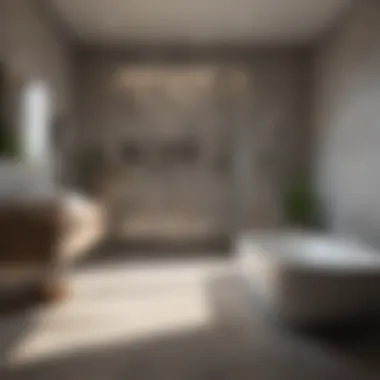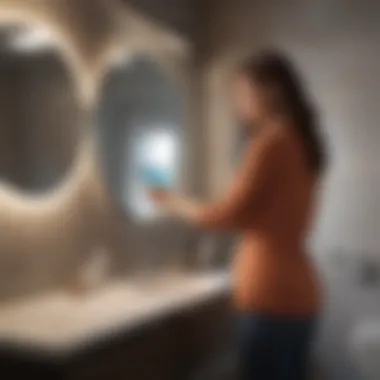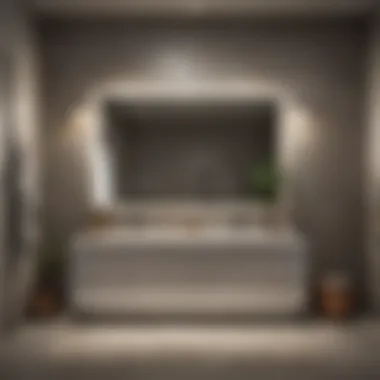Free Virtual Bathroom Designer: Tools and Insights


Intro
In the world of home improvement, particularly in bathroom renovation, virtual designers offer a bridge between creativity and practicality. The idea of visualizing space can greatly enhance the decision-making process for homeowners and interior designers. A virtual bathroom designer provides tools that assist in transforming raw ideas into reality, showcasing how materials and layouts interact in a given space. The focus here is not only on what these tools entail but also on how they empower users to take control of their renovation processes.
Materials:
To kickstart your bathroom project with a virtual designer, you need a comprehensive list of materials. A well-prepared list will save time and enhance the planning stage significantly. Key materials, along with their specifications, can include:
- Tile: 12” x 12” ceramic tiles for floor and wall, around 60 square feet
- Paint: Semi-gloss bathroom paint, approximately 1 gallon
- Vanity Cabinet: Single sink vanity measurements about 30” wide
- Sink: Standard undermount sink, preferably 22” x 18”
- Faucet: Pull-down kitchen style faucet that fits standard plumbing measurements
- Lighting Fixtures: Wall-mounted sconces, ideally a 75-watt equivalent
- Accessories: Towel bars, toilet paper holder, and mirror to complement the layout
Making a detailed list eases the shopping process and ensures nothing essential is forgotten.
DIY Steps:
When planning the installation of your new bathroom, precise instructions are paramount. Following these streamlined steps can aid a seamless renovation:
- Initial Planning and Design: Use the virtual bathroom designer to sketch your layout. Including dimensions during this step is essential for accuracy.
- Prepare the Area: Clear the bathroom of furniture and fittings, accounting for any plumbing that may need rerouted.
- Wall Prep: Fix and seal any damage, taking care of mold and debris before applying paint or tiles.
- Tile Installation: Start by laying tiles from the center of the room for symmetrical balance, using spacers for consistency.
- Install Fixtures and Vanities: Ensure plumbing connections are water-tight and properly fitted.
- Finish with Accessories: Once everything is set, add your lighting, towel bars, and mirror.
These steps should help ensure that nothing is overlooked along the way.
Technical Aspects:
In terms of tools needed for your project, a comprehensive list may include:
- Level: For ensuring all fittings are accurately aligned
- Tile Cutter: Essential for precise cuts
- Drill and Bits: For securing fixtures and fittings
- Sponge: For cleaning grout o During the installation, anticipate taking around 2-4 days, depending on the complexity of the project.
Critical techniques may involve:floating tiles, which requires precision when laying your patterns, andproper sealing of sinks and fixtures to prevent leaks and enhance longevity.
DIY Project Process:
In following a set method when executing your plan:
- Organize Your Materials: All materials should be onsite for maximum efficiency.
- Establish Timelines: A realistic timeline helps avoid frustration, specify each phase: planning, execution, and finishing.
- Frequent Measurements: Keeping a consistent checking process ensures that all products get installed correctly.
- Observe Condition Changes: Identify if there's an unpredicted issue, like uneven floors, and prepare accordingly.
Troubleshooting Tips:
If during the project errors occur, here are key simple solutions:
- Water leaks can often result from loose fittings. Retighten connections.
- Uneven tile surfaces may need adjustments in leveling or application of extra adhesive.
- If paint streaks appear, reapply fresh paint lightly using smooth brush strokes.
Renovating your bathroom with a virtual tool is one that alleviates stress by putting the design in your hands.
With this structured approach and utilizing a virtual designer’s capacity, your bathroom can finally mirror your vision perfectly.
Understanding Virtual Bathroom Design
Virtual bathroom design marks a significant leap in the way homeowners and interior designers approach remodeling spaces. This modern approach facilitates a highly interactive and immersive experience, allowing users to visualize their bathroom transformations before making any real world changes. Important elements in this discussion include the definition of virtual design, the evolution of its technology, and its implications for planning and renovation.
Definition and Purpose
Virtual bathroom designers are digital tools that enable users to create, modify, and visualize bathroom designs in a virtual format. These tools offer an intuitive platform where homeowners can experiment with layouts, colours, fixtures, and accessories - all while seated at their computers or even using handheld devices. The primary purpose of these tools is to simplify the process of designing a space that aligns with personal tastes and functional needs.
In phenomenon like home improvement, trial-and-error can be costly and time-consuming. Virtual design tools eliminate the risks associated with misguided decisions by allowing users to see how their ideas come to life before engaging contractors or purchasing materials. This does not only save money but also keeps stress at bay by providing a clearer vision.


Evolution of Bathroom Design Technology
The journey of bathroom design technology has accelerated dramatically in recent years. From basic layouts drawn on paper to advanced 3D modelling tools, technology has continually aimed to make design accessible to everyone. Historically, homeowners relied heavily on interior designers to translate their ideas into physical plans. With the advent of user-friendly applications, this reliance has diminished. Today’s virtual bathroom designers incorporate 3D rendering, allowing users to view real-time designs with depth and detail. Such advancements highlight a shift toward inclusive design practices that empower individuals. As technology continues to evolve, further innovations like augmented reality and connections with smart home systems may redefine how we perceive renovations.
Experience your dream bathroom before making an investment. Virtual spaces make visualization possible and enjoyable.
Features of Free Virtual Bathroom Designers
Understanding the features of free virtual bathroom designers is crucial. These tools simplify home renovation and empower users to realize their design ambitions. They provide an avenue for creativity, allowing homeowners to visualize and plan their ideal bathrooms without the significant investment often required by traditional design approaches. The blend of technology with the aesthetic sensitivity of users is fundamental to the effective city and integration of these tools.
User Interface and Experience
One key aspect of any free virtual bathroom designer is its user interface. A clear and intuitive interface allows users to navigate through the design process with ease. These applications often use a drag-and-drop method to place elements, such as toilets and vanities, in a virtual space. An effective UI enhances coherence and streamlines the experience, keeping users engaged and less frustrated. Simple layouts are attractive and facilitate quicker designs. For users who are unfamiliar with technology, a straightforward interface also minimizes the learning curve.
3D Visualization Capabilities
The importance of 3D visualization capabilities cannot be overstated. Users wish to see their design decisions in a realistic context. Good software offers accurate rendering of materials, colors, and lighting options. This realism contributes to a more informed decision-making process. Homeowners can experiment with various configurations without making irrevocable changes to their actual space. Detailed 3D images help users understand spatial relationships, making it easier to determine suitable placements for fixtures and furniture.
Customization Options
Versatility is another hallmark of virtual bathroom designer tools. Customization options must allow for personal expression. Users appreciate being able to select styles, colors, and materials that align with their vision. Toolboxe that provide a wider array of fixtures and fittings not only enhance creativity but also lead to more satisfying outcomes. When users have the opportunity to tailor designs to their tastes, the end result often reflects their preferences more accurately, leading to greater satisfaction with the final product.
Cost-effectiveness and Accessibility
Accessibility and cost-effectiveness are significant advantages of these tools. Free virtual bathroom designers eliminate barriers to entry for redesigning a bathroom. Homeowners no longer need to employ expensive designers or buy costly software. Many tools offer substantial features at no cost, opening new avenues for homeowners who thought renovation was unattainable. This has democratized the interior design. Even those with weekned handyman skills can navigate renovations because effective layouts are simpler to achieve.
A successful virtual bathroom design tool will reduce expenses while enhancing personal involvement in decorating and renovating spaces.
Popular Free Virtual Bathroom Design Tools
Exploring popular free virtual bathroom design tools is critical to understanding the full potential of these resources. As homeowners or interested individuals consider ways to improve or transform their spaces, having access to effective tools may greatly accelerate their design process. These resources empower users with design flexibility, enhance creative exploration, and offer realistic previews of potential renovations.
Design Your Own Bathroom
Many free virtual bathroom design tools now available on the market allow users to engineer their unique spaces. For example, tools like Roomstyler and Homestyler enable users to essentially create a virtual version of their bathrooms from scratch. By utilizing a robust catalog of items, such as bath fixtures, tiles, and accessories, these platforms offer a visually dynamic way to mistake, facilitating endless customization.
Creating an intimate work area at home or transforming a space for guests becomes manageable with these designers. Simply clicking and dropping elements in realistic scales accomplish realistic mood boards.
A significant feature often found in such systems is the full 3D viewing mode, allowing users to navigate their designs in a virtual environment. The ease of interface encourages a step-by-step approach to altering dimensions, color palettes, and styles, complementing user’s choices in real time. What may typically feel like a daunting task becomes engaging and enjoyable.
Bathroom Design Software Comparison
In making well-informed choices, it helps to analyze the functionalities of various design tools. Some tools stand out more than others based on user experience and the extent of free offerings. For instance:
- SketchUp Free - Known for its comprehensive modeling capabilities, enabling intricate designs, yet has a slightly steeper learning curve.
- IKEA Home Planner - Perfect for those thinking of integrating IKEA products, giving free access to IKEA's extensive catalogue.
- Virtual Bathroom Planner by MR. BATHROOM - User-friendly with specific bathroom focus; excellent for novices.
To conclude the comparison, it’s fundamentally important to evaluate user needs. Those focused primarily on visual matching may take to simpler platforms, while others aiming for complex structure and arrangement might select more robust software.
Case Studies of User Experiences
User experiences reveal the tangible benefits these tools provide. One documented case involved a homeowner named Sarah, who utilized Roomplanner and discovered how easily the platform aided in achieving her vision. Putting it into perspective, Sarah documented how moving virtual features led her to reconsider layouts, saving time compared with physical mock-ups in her house. Positive testimonials often highlight emotional satisfaction—seeing a shape shifting from design instance into physical manifestation is rewarding.


In another case, John used Planner 5D, marvelling at how accessible all design features were—creating everyday spaces tailored not just aesthetically but also efficiently. Positive designer aesthetic considerations have shown how modern tools liberate designers from creative limits.
To summarize, popularity stems from these tools effectively connecting innovative functionality with usability. With an array of favorable tools, the fundamental element engaging ones’ creativity lies in selecting a service aligning with personal needs as well as desired style. One should always stay informed on available features and user experiences.
Virtual bathroom design software can significantly expedite the planning phases while grinding personal satisfaction. Essential outcomes initiated depend largely on selecting an appropriate tool that fits one’s working style.
Benefits of Using Virtual Bathroom Designers
Virtual bathroom designers provide significant advantages in the realms of home renovation and personal design. Understanding these benefits can empower homeowners, particularly housewives and owners, to make informed choices when planning their bathroom designs. This section outlines key advantages, bringing attention to enhanced visualization, streamlined planning processes, and potential cost savings.
Enhanced Visualization of Design Ideas
One of the most compelling reasons to use virtual bathroom designers is the enhanced visualization they offer. Traditional design methods often rely on two-dimensional sketches. These don’t truly convey how a space will come together.
Virtual designers allow users to create realistic 3D models of their bathrooms. By manipulating various styles, colors, and layouts in real time, users can witness myriad combinations. This hands-on interaction with the design helps to identify elements that resonate or conflict within a proposed space. Comments from users highlight that seeing a virtual render often leads to Aha! moments where decisions concerning placement and size click into alignment.
“Seeing the 3D representation made my selection of both fixtures and tiles so much easier. I felt like I was in the space before it was built!”
This form of visualization proves crucial especially if several design concepts overlap. Efficiently analyzing and refining these concepts builds confidence, reducing potential regret once physical labor begins.
Streamlined Planning Process
Another advantage is the way virtual bathroom designers can significantly streamline the planning process. Renovation projects, especially concerning bathrooms, can become overwhelming without proper organization.
Virtual tools integrate functions that help outline each design step clearly. They often include checklists, material options, and layout features. Everything is digitized which means the need for physical samples can lessen. This allows homeowners to focus on making design decisions rather than getting bogged down in minute details.
Smooth software interfaces contribute to an efficient workflow. From placing items to adjusting minor aesthetic details, the tools reduce back-and-forth exchanges typical in professional approaches. Users find satisfaction in experimentation, either swapping a toilet for a vanity or testing various shades of paint against features. Planning becomes a fluid experience rather than a rigid set of tasks.
Cost Savings in Design and Renovation
Cost considerations are a main worry for many homeowners. Free virtual bathroom design tools enable users to explore various materials and configurations without financial commitment. By carefully selecting budget-friendly options directly visualized in 3D, there is a better chance of avoiding overspending during the renovation.
Implementing a design digitally before making any purchases reduces the risk of making costly mistakes. If an expensive material turns out to not fit stylistically or aesthetically in real life, that foresight can save substantial money. Encouraging prospective users, multiple positive accounts boast about the ability to visualize which design solutions are truly feasible under tight financial restraints.
Additional features built into these platforms may also compare costs for various designs, straight away giving users information on financial implications of their choices. As a result, virtual bathroom designers serve not only as a canvas for creativity but also a voracious tool against excessive spending.
Being educated about the benefits of virtual bathroom designers significantly influences the planning journey of individuals looking to enhance their spaces. These insights assure users that embracing this technology leads to richer, more satisfying outcomes in every renovation effort.
Limitations of Free Virtual Bathroom Designers
While the appeal of free virtual bathroom designers can be undeniable, it is crucial to address their limitations. Recognizing these constraints can help user to make informed decisions, and manage expectations while planning their design projects. This section focuses on aspects such as functionality constraints, the learning curve associated with new tools, and support options frequently available in free software.
Functionality Constraints
Free virtual bathroom designers may exhibit functionality constraints that can hinder the user experience. These tools usually offer limit features compared to their premium counterparts which can create issues during the design process. Opting for a simpler version can result in missing key components. Here are frequent limitations:
- Restricted Design Tools: Some platforms may not offer full-fledged design capabilities like detailed 3D rendering or advanced materials editing.
- Fixed Templates: Users may have to work with predefined layouts. This often inhibits creativity and customization, making it harder to realize unique design visions.
- Limited Measurement Options: Accurate measurements are critical. Some free tools do not offer comprehensive tools for measuring spaces.
Understanding such limitations is important for target users who want to make the best choices for their individual needs or enhance their design concepts.
Learning Curve for New Users


The learning curve is another aspect users must sometimes face. Although the premise of simple user experiences is often promoted, the reality can be different. Predictably, high-quality tools often come with technical complexities. Thus, learning to effectively navigate a virtual designer can feel daunting at times. Specific challenges may include:
- Complex Interfaces: Overall layout may confuse users, leading to frustration instead of satisfaction. A dazzling interface often necessitates time to master.
- Lack of Intuitive Controls: Free versions may not always provide clear guides or tutorials. This can exacerbate users’ struggles, leaving them feeling lost.
It is therefore essential for novice users to take their time with training materials or leverage online resources for learning.
Potentially Limited Support Options
The support available for free tools is often notably limited. Advanced paid tools typically grant broad support, while free models might present less responsiveness. What this means is:
- Response Time: User feedback may not be answered promptly, leading to frustration. Standard question turnaround can take longer.
- Minimal Resources: Resources such as documentation or tutorials are sometimes underwhelming. This presents suitable obstacles for users in need of assistance while design is suspected to it.
- Community Reliance: Instead of direct professional support, users usually rely on online communities for troubleshooting, which may not always provide solutions effectively.
Despite the appealing world of virtually modern design tools, being aware of limitations allows users to properly align their expectations. They can then strategically choose accordingly!
By critically assessing these limitations, homeowners and house owners can better navigate the world of virtual bathroom design. These considerations can inform users about their next steps, which enhance their overall design journey.
The Future of Virtual Bathroom Design
The future of virtual bathroom design is an evolving frontier that promises to reshape not just how we visualize and execute bathroom projects, but also how we integrate technology into our everyday home environments. The demand for innovation is at an all-time high, as more homeowners seek dynamic tools that allow them to customize their spaces effortlessly. As engineers and designers harness increasingly sophisticated software, the implications of virtual design technology widen, prompting deeper reflections on user experience, accessibility, and integration potential.
Trends in Virtual Design Technology
Virtual bathroom design technology has seen several fundamental trends emerge. One significant shift is the increasing use of augmented reality (AR). With AR, users can visualize how different elements like tiles, fixtures, and colors will interact in real-time within their own space. This immediacy enhances decision-making and can illustrate how individual styles coexist in the real world. Moreover, there’s a growing inclination towards cloud-based platforms. These resources allow seamless sharing and collaboration, empowering users to refine designs collectively with family members or friends.
New capabilities are also emerging in rendering quality, allowing users to experience detail and realism previously unavailable to the average homeowner. Enhanced lighting effects, shadowing, and textures improve the overall visual experience, making planning more intuitive. Users are not just passive players; they now engage actively with the tools, turning the design process into a more interactive experience.
Potential Integrations with Smart Home Systems
The rise of smart home devices opens new avenues for virtual bathroom design. Integration with smart home systems allows for seamless operation of various functionalities from a single platform. Homeowners will be able to design spaces that not only meet their aesthetic needs but also connect various systems such as lighting, ventilation, and heating.
Instead of viewing their bathrooms in isolation, users can consider communal functionality among different designated areas of their homes. For example, a user can plan for smart faucets equipped with motion sensors while coordinating it with a smart shower and mood lighting enacted via an app. This interconnectedness provides a more cohesive, efficient bathroom system.
Moreover, as advancements accelerate in terms of artificial intelligence, future virtual design applications may even offer personalized design suggestions based on users’ habits and preferences. This ensures that the bathroom is designed not just for visual appeal, but for actual usability as well.
Impact on Professional Interior Design Practices
The role of virtual bathroom design tools also poses intriguing questions regarding professional interior design. Some industry professionals express concern that these software tools may lessen the demand for specialized services.
However, many others argue that virtual design tools are essential in modern practice. They empower designers to produce complex layouts quicker and those once seen as follow stages can now also be a collaboration mechanism, leading to clearer communication between designers and clients.
By adopting these technologies, professionals can focus on the nuanced elements of design that software cannot grasp. Their expertise expands to include nurturing collaboration with clients throughout the design process rather than simply executing plans. The knowledge of material quality, craftsmanship, and trends provides depth that TB application alone lacks.
In summary, while virtual bathroom design technology democratizes the planning process, it also opens many opportunities for interior designers to leverage technology while enriching the overall design experience for homeowners.
Ending
The conclusion of this article underscores the vital lessons and insights garnered from examining free virtual bathroom designers. It not only encapsulates overall findings but also invites readers to consider how these tools aptly address the needs of homeowners. Understanding fundamental aspects, such as usability, customization, and visualization options, proves crucial for anyone embarking on a renovation journey.
Summary of Key Takeaways
- User-Friendly Interfaces: These virtual tools prioritize ease of use, enabling users from various backgrounds to design their bathrooms effectively.
- 3D Visualization: Effective visual representation helps homeowners visualize changes, leading to informed decisions about design choices.
- Cost Savings: Utilizing free platforms not only reduces expenses on traditional design services but encourages creative engagement in the renovation process.
- Limitations: Despite the many benefits, some users experience challenges. Functionality constraints and a steep learning curve remain crucial considerations when choosing tools.
The integration of virtual bathroom design technology into home improvement strategies signifies a shift in how we approach remodeling; it marries practicality with creative freedom.
Final Thoughts on Digital Design Tools
Using digital tools in bathroom design simplifies processes and brings innovative solutions to life. With ongoing advancements in technology, it’s reasonable to expect the virtual landscape to evolve even further. As more integrated solutions become available, these tools offer a deeper connection between personal style and functional needs.
New users should keep in mind that each tool features its unique capabilities. Thorough research on tools not only ensures wise choices but also enables homeowners to align their visions with the right assistance. Whether one aims to explore possibilities for a sleek modern bathroom or a cozy rustic retreat, free virtual bathroom designers provide essential creative and practical assistance necessary for realizing remodel goals.







